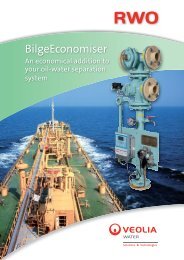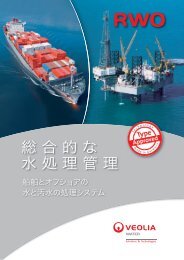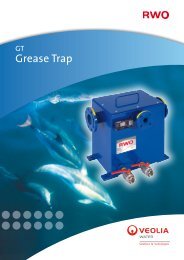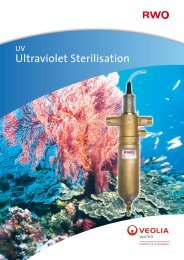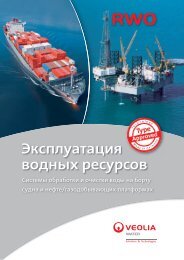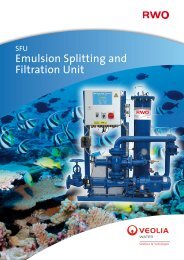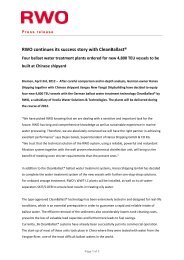the IHS Ballast Water Guide - RWO Marine Water Technology
the IHS Ballast Water Guide - RWO Marine Water Technology
the IHS Ballast Water Guide - RWO Marine Water Technology
You also want an ePaper? Increase the reach of your titles
YUMPU automatically turns print PDFs into web optimized ePapers that Google loves.
<strong>IHS</strong> Fairplay Solutions <strong>Guide</strong> to <strong>Ballast</strong> <strong>Water</strong> Treatment Systems Sponsored by<br />
Magneto Special Anodes for <strong>the</strong> development<br />
of advanced electrolysis technology. Upon<br />
de-ballasting, <strong>the</strong> system neutralises any<br />
remaining active substance using sodium<br />
bisulphite, ensuring that <strong>the</strong> ballast water can<br />
be safely discharged back to <strong>the</strong> sea.<br />
The Aquarius systems achieve filtration<br />
using automatic backwashing screen filter<br />
technology. The filter is designed specifically<br />
for ballast water applications and filters<br />
particulates down to 40µm. Operation of<br />
<strong>the</strong> filter includes automatic backwashing to<br />
ensure efficient removal of particles that are<br />
discharged back to <strong>the</strong> environment of origin;<br />
<strong>the</strong> systems are PLC-controlled with userfriendly<br />
touchscreen operation. All relevant<br />
data is stored by <strong>the</strong> programmable logic<br />
controller in line with IMO requirements<br />
and <strong>the</strong> system can be fully integrated into<br />
<strong>the</strong> main control system to achieve complete<br />
ballast water management on board ship sh ship. ip. ip<br />
Clear<strong>Ballast</strong><br />
Hitachi<br />
1 2<br />
The Clear<strong>Ballast</strong> ballast water purification<br />
system was developed jointly by Japanese<br />
industrial giants Hitachi Plant Technologies<br />
and Mitsubishi Heavy Industries. It uses<br />
coagulation technology to remove plankton<br />
and organisms, and magnetic separation<br />
equipment to remove algae.<br />
The coagulation method differs from<br />
sterilisation techniques, in that it does<br />
not use chlorine, UV rays or disinfectants,<br />
thus removing <strong>the</strong> possibility of secondary<br />
contamination by residual chlorine.<br />
Seawater taken in is treated by adding<br />
a coagulant and magnetic powder in<br />
coagulation and flocculation tanks. Agitation<br />
of <strong>the</strong> water causes plankton, viruses and<br />
mud to coagulate into 1mm-wide magnetic<br />
flocs. These can <strong>the</strong>n be collected with<br />
magnetic discs in a magnetic separator.<br />
Treated water is filtered through a filter<br />
separator and injected into <strong>the</strong> ballast tanks.<br />
The coagulation of micro-organisms into small<br />
flocs enables <strong>the</strong> use of coarse filters, which is<br />
claimed to result in high-speed treatment.<br />
The flexible design is suitable for a wide<br />
range of capacities and can be modelled to fit<br />
<strong>the</strong> space available. Mud accumulation is said<br />
to be greatly reduced, <strong>the</strong>reby prolonging <strong>the</strong><br />
life of <strong>the</strong> coating of <strong>the</strong> ballast tank.<br />
k.<br />
Guardian<br />
Hyde <strong>Marine</strong><br />
2 3<br />
Destruction of micro-organisms by US-based<br />
Hyde <strong>Marine</strong>’s Guardian is achieved using<br />
medium-pressure UV, with a separation<br />
unit consisting of a stacked disc filter<br />
with automatic backflushing. This can be<br />
complemented by a Hyde Mud Remover<br />
dosing unit, which contains a liquid cationic<br />
polymer that is considered to be nonhazardous<br />
and non-toxic.<br />
The system works on <strong>the</strong> principle of<br />
flocculation, attracting mud particles into<br />
flocs, which do not pack down in <strong>the</strong> ballast<br />
tanks as natural sediment does and which are<br />
easily flushed away during deballasting.<br />
The polymer is injected into <strong>the</strong> ballast<br />
piping during ballasting from a tank of<br />
between 250 and 500 litres capacity<br />
depending on <strong>the</strong> size of <strong>the</strong> ship. The<br />
injection systems can be supplied in<br />
automatic or semi-automatic versions. The<br />
Hyde Guardian system is of modular design<br />
and <strong>the</strong> two main units – <strong>the</strong> filter and <strong>the</strong><br />
UV treatment chamber – can be installed<br />
separately or as a skid-mounted system.<br />
A control panel controls <strong>the</strong> system’s two<br />
main components and <strong>the</strong> booster pumps<br />
and valves. During ballasting, <strong>the</strong> ballast<br />
water passes through <strong>the</strong> filter and UV<br />
20 © <strong>IHS</strong> Global Limited 2012<br />
012_037_CorrectedBW1204.indd 20 01/08/2012 15:32:50



